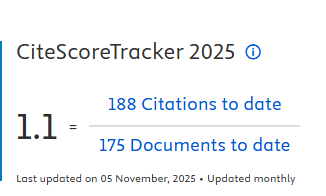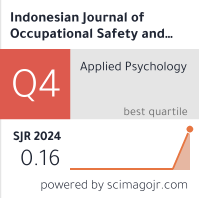Risk Factors Affecting Dry Eye Symptoms among Visual Display Terminal Users

Downloads
Introduction: Dry eye symptoms are the common ocular complaints that are found at the ophthalmologic outpatient services. This research's main purposes were to study the risk factors associated with dry eye symptoms and to evaluate the severity of dry eye among Visual Display Terminal (VDT) users. Methods: This study was a descriptive observational study involving 104 VDT users in 3 branches of the Social Security Offices and the Bureau of Labor Protection and Welfare in Samutprakarn province, Thailand. The study instruments used were: (1) questionnaires associated with VDT use and dry eye symptoms that were evaluated by using the Ocular Surface Disease Index (OSDI) and (2) Lux meter for desk-brightness and the angle of gaze measurement during VDT use. Data were analyzed using a Chi-square test and multiple logistic regression. Results: The results found that VDT users had severe dry eye symptoms, accounting for 51.9%, and experienced moderate and mild dry eye symptoms in the same number, which was 24.0%. In addition, dry eye symptoms were related to VDT use for 5-7 hours/day with statistically significant value. Other VDT use factors, including the desk-brightness or the angle of gaze during VDT use, were related to severe dry eye symptoms with no statistically significant difference. Conclusion: Based on the findings, VDT users should use VDT no more than 5 hours/day in order to reduce VDT-related dry eye symptoms. these factors were not statistically significant for the occurrence of severe dry eye symptoms.
Syndrome Among Health Sciences Students in Saudi Arabia: Prevalence and Risk Factors', Cureus, 12(2), pp. 2–7.
Argilés, M. et al. (2015) ‘Blink Rate and Incomplete Blinks in Six Different Controlled Hard-Copy and Electronic Reading Conditions', Investigative Ophthalmology and Visual Science, 56(11), pp. 6679–6685.
Bouffard, M. A. (2019) ‘The Pupil', Continuum, 25(5), pp. 1194–1214.
Courtin, R. et al. (2016) ‘Prevalence of Dry Eye Disease in Visual Display Terminal Workers:A Systematic Review and Meta-Analysis', BMJ Open, 6(1), pp. 6–13.
Craig, J. P. et al. (2017) ‘TFOS DEWS II Definition and Classification Report', Ocular Surface, 15(3), pp. 276–283.
Department of Labor Protection and Welfare (2017)‘Announcement of the Department of Labor Protection and Welfare, Ministry of Labor; The standard of light intensity', The Royal of Thai Government Gazette of The Kingdom of Thailand. Bangkok.
Fjí¦rvoll, H. et al. (2021) ‘The association between visual display terminal use and dry eye: a review', Act Ophthalmologica, pp. 1–19.
Greco, G. et al. (2021) ‘Association of Severity of Dry Eye Disease with Work Productivity and Activity Impairment in the Dry Eye Assessment and Management Study', Ophthalmology, 128(6), pp. 850–856.
Kawashima, M. et al. (2015) ‘Screening of Dry Eye Disease in Visual Display Terminal Workers during Occupational Health Examinations: The Moriguchi Study', Journal of Occupational Health, 57(3), pp. 253–258.
Mowatt, L. et al. (2017) ‘Computer Vision Syndrome and Ergonomic Practices among Undergraduate University Students', The International Jornal of Clinical practice, 72(1), p. e13035.
Lekhanont, K. (2018) Dry Eye Disease. 1st edn. Bangkok: Faculty of Medicine Ramathibodi Hospital.
Mallik, D. et al. (2017) ‘Prevalence of Dry Eye amongst Computer Workers in Kanpur', International Journal Of Community Medicine And Public Health, 4(7), p. 2308.
McDougal D.H and Gamlin P.D (2015) ‘Autonomic Control of the Eye.', Comprehensive Physiology, 5(1), pp. 439–73.
National Statistical Office (2018) ‘Update the Information Technology and Information Technology Survey program in the Workplace 2018', Ministry of Digital Economy and Society of The Kingdom of Thailand. Bangkok.
Office of the National Digital Economy and Society Comission (2017) ‘National policies and plans on digital for digital 2018 - 2037', Ministry of Digital Economy and Society of The Kingdom of Thailand. Bangkok.
Rajprachasamasai Institute (2019) The result of the survey of dry eye disease among medical and public health personnel, Rajpracha Samasai Institute. Samutprakarn.
Ranasinghe, P. et al. (2016) ‘Computer Vision Syndrome among Computer Office Workers in a Developing Country: An Evaluation of Prevalence and Risk Factors', BMC Research Notes, 9(1), pp. 1–9.
Randolph, SA. (2017) ‘Computer Vision Syndrome', Workplace Health and Safety, 65(7), p. 328.
Rossi, G. et al. (2019) ‘Prevalence of Dry Eye in Video Display Terminal Users: A Cross-Sectional Caucasian Study in Italy', International Ophthalmology, 39(6), pp. 1315–1322.
Rungsirisangratana, C., Pinsuwannabud, P. and Hirunphasert, C. (2020) ‘Computer Vision Syndrome among Office Workers in Three Factories in Phrapradaeng District, Samutprakarn Province', Journal of Preventive Medicine Association of Thailand, 10(1), pp.21–35.
Sánchez-Valerio, M. D. R. et al. (2020) ‘Dry Eye Disease Association with Computer Exposure Time among Subjects with Computer Vision Syndrome', Clinical Ophthalmology, 14, pp. 4311–4317.
Schiffman, R. M. et al. (2000) ‘Reliability and Validity of the Ocular Surface Disease Index', Archives of Ophthalmology, 118(5), pp. 615–621.
Stapleton, F. et al. (2017) ‘TFOS DEWS II Epidemiology Report', Ocular Surface, 15(3), pp. 334–365.
Titiyal. JS, Falera. RC, Kaur. M, S. V. and S. N. (2018) ‘Prevalence and Risk Factors of Dry Eye Disease in North India: Ocular Surface Disease Index"‘based Cross"‘Sectional Hospital Study', Indian Journal of Ophthalmology, 66, pp. 207–211.
Tubtimhin, S. and Puthaburi, N. (2019) ‘Prevalence and Severity of Computer Vision Syndrome of Supporting Staff in Ubon Ratchathani University', Srinagarind Medical Journal, 34(2), pp. 173–177.
Wolffsohn, J. S. et al. (2017) ‘TFOS DEWS II Diagnostic Methodology report', Ocular Surface, 15(3), pp. 539–574.
Copyright (c) 2022 The Indonesian Journal Of Occupational Safety and Health

This work is licensed under a Creative Commons Attribution-NonCommercial-ShareAlike 4.0 International License.

In order to be accepted and published by The Indonesian Journal of Occupational Safety and Health, Author(s) who submit an article should complete all the review process. The copyright of received articles assigned to the The Indonesian Journal of Occupational Safety and Health and Department of Safety and Health, Universitas Airlangga as publishers of the journal. The intended copyright includes the rights to publish articles in various forms (including reprints).
The Editorial Team of The Indonesian Journal Of Occupational Safety and Health and Department of Safety and Health strive to ensure that no errors occur in the articles that have been published, both data errors and statements in the article.
Users of this website will be licensed to use materials from this website following the Creative Commons Attribution-NonCommercial-ShareAlike 4.0 International License. No fees charged. Please use the materials accordingly.
------------------------------------------------------------------------------------------------------------------------------------------------------------------------------------------
Attribution ” You must give appropriate credit, provide a link to the license, and indicate if changes were made. You may do so in any reasonable manner, but not in any way that suggests the licensor endorses you or your use.
NonCommercial ” You may not use the material for commercial purposes.
ShareAlike ” If you remix, transform, or build upon the material, you must distribute your contributions under the same license as the original.







 How to Submit Articles in OJS
How to Submit Articles in OJS

























